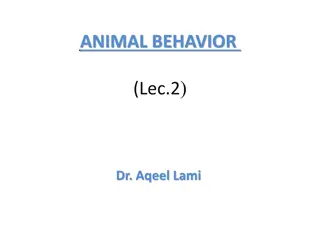
Qualitative Research: Philosophical Foundations and Methodologies
This content explores the philosophical underpinnings of qualitative research, highlighting the key differences between qualitative and quantitative approaches. It delves into the features of qualitative research, including the inductive view, epistemological and ontological positions, and characteristics of designing a qualitative study. By emphasizing narrative and descriptive methods, this summary provides valuable insights into the essential elements that shape qualitative research methodologies.
Download Presentation

Please find below an Image/Link to download the presentation.
The content on the website is provided AS IS for your information and personal use only. It may not be sold, licensed, or shared on other websites without obtaining consent from the author. If you encounter any issues during the download, it is possible that the publisher has removed the file from their server.
You are allowed to download the files provided on this website for personal or commercial use, subject to the condition that they are used lawfully. All files are the property of their respective owners.
The content on the website is provided AS IS for your information and personal use only. It may not be sold, licensed, or shared on other websites without obtaining consent from the author.
E N D
Presentation Transcript
PHILOSOPHIC UNDERPINNINGS OF QUALITAT VE RESEARCH Prof. Dr. ehnaz ahinkaraka
Main differences between Qualitative and Quantitative Research Quantitative: Based on observations that are converted into discrete units that can be compared to other units by using statistical analysis. Based on a positivist position Qualitative: Examines people s words and actions in narrative or descriptive ways (closely representing the situation as experienced by the participants) Based on a phenomenological position
Three features of qualitative research Inductive view: relationship between theory and research, (the former is generated out of the latter) Epistemological position (interpretivist): the stress is on the understanding of the social world through an examination of the interpretation of that world by its participants (NOT the adoption of a natural scientific model in quantitative research)
Ontological position (constructionist): Social properties are outcomes of the interactions between individuals, rather than phenomena out there and separate from those involved in its construction.
Characteristics of designing a qualitative research A qualitative study reflects the researcher s goal of discovering what is important to know It has a focus which is broad and open-ended at the beginning and it allows for important meanings to be discovered. There may be 8 characteristics of qualitative research:
1. An exploratory and descriptive focus Qualitative research develops a general focus of inquiry Interested in investigating and responding to exploratory and descriptive questions: What is young children s conception of mind ? How do people who work in this place think the physical environment could be improved? In what ways do teachers in this city build informal social network? The outcome of such studies is not to generalize but to get a deeper understanding of experience from others perspectives.
2. Emergent design In non-emergent design, we collect the data according to the focus and then analyze (qualitative and quantitative) In emergent design, in the early phases of data collection, new questions can be pursued. Thus, we can broaden or narrow the focus during the study.
3. A Purposive sample Carefully selected participants, who represent the group of people for the focus of inquiry E.g. If you want to understand how young learners in rural areas use technology, you would include people who have access to technology in rural areas As your study proceeds, you may need to include some other people to fully understand your inquiry.
4. Data collection in natural setting People s experience in context Personal meaning is tied to context E.g. To understand how teachers give feedback, you would need to go to the classrooms.
5. Emphasis on human-as- instrument Qualitative researchers mutual responsibility: i) Collecting relevant data ii) Collecting the meaning from that data (in the form of people s words and actions).
6. Qualitative methods of data collection Generally data is people s words and actions Some techniques: Participant observation Interviews Collection of relevant documents How to collect: Observation schemes Field-notes Audio/video tapes (transcribed later).
7. Early and ongoing inductive data analysis Two main characteristics: Ongoing research activity Inductive (What is important is not predetermined by the researchers)
8. A case study approach to reporting outcomes Results are presented in a rich narrative way. Description should provide the reader with enough information to determine whether the findings of the study apply to other people or settings.
Approaches to Qualitative Research Phenomenological Grounded Theory Ethnography Exploratory-descriptive-qualitative Historical
Phenomenology Provides a rich description of the lived experience
Grounded Theory Symbolic Interaction Theory Meaning is attached to things or actions which form our reality Often result in theory development
Ethnography Based in anthropology Focus on understanding the culture
Exploratory-Descriptive No specific approach described except for naturalistic inquiry, descriptive, or qualitative Addresses the research purpose and question from a qualitative method
Historical Examination and description of events or other factors that influence what you are interested in
Main Steps in Qualitative Research
The Critique of Qualitative Research 1. Qualitative research is too subjective. a) Relies on the researcher s unsystematic views about what is important close personal relationships between the researcher and the people studied b) Begins in an open-ended way & gradually narrows down, so few clues are given / why one area was the chosen area is not very clear
2. It is difficult to replicate Almost impossible to conduct a true replication there is no standard procedure The researcher chooses what to focus The responses may be affected by the characteristics of the researcher (personality, age, gender, etc)
3. Problems of generalization Scope of the findings is restricted (Normally the findings of qualitative research are to generalize to theory rather than to populations it is the quality of theoretical inferences that are made out of qualitative data that is crucial to the assessment of generalization.)
There may be some moderate generalizations Aspects of focus of inquiry (e.g. a group of demotivated students) can be seen to be instances of a broader set of recognizable features. The researcher can draw comparisons with findings by other researchers relating to similar or contradictory groups.
Moderate generalizations are always limited and somewhat more tentative than statistical generalizations. But, they permit a little generalization and help to oppose the view that generalization beyond the immediate evidence and the case is impossible in qualitative research.
4. Lack of transparency Sometimes difficult to establish from what the researcher actually did and how he or she arrived at the study s conclusions. Process of qualitative data analysis may be unclear. However, giving the details about participant selection, data analysis, etc. may help this problem
Lets Discuss! 1. Which of the following is true about qualitative research? A.Categories are established for analysis purposes. B.Data are usually collected in a laboratory setting. C.Focus is on studying the whole. D.Intuition and abstraction are suppressed.
Answer: C Qualitative research focuses on understanding the whole. Generally the plan for analysis occurs after the data are collected. Data are collected in naturalistic settings. The researcher often uses intuition while collecting data and must be able to abstract when analyzing it.
2. Data for qualitative studies are: A. Based on words rather than numbers. B. Easy and straightforward to interpret. C. Gathered quickly from large numbers of people. D. Precisely analyzed on a computer.
Answer: A In each approach to qualitative research, the purpose is to examine meaning, and the unit of analysis is a word or phrase instead of a numerical value. Data are neither easy nor straightforward to interpret. Qualitative data collection often takes a long time and must be conducted individually. Although computer programs are available to assist with analysis, many researchers still find them cumbersome and incomplete.
3. Which of the following is not a common data collection method in qualitative research? A. Examining written text B. Interviewing participants C. Observing participants D. Obtaining written surveys
Answer: D Survey research is a type of quantitative research. Data collection methods in qualitative research include observing participants, interviewing participants, and examining written text.






















